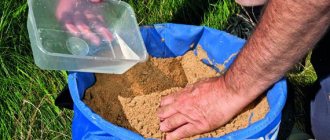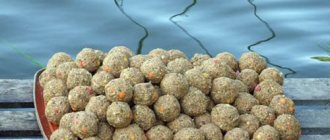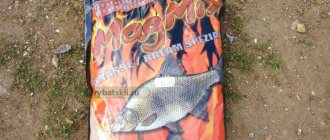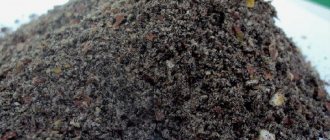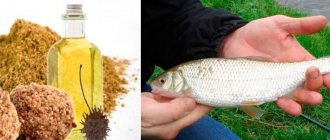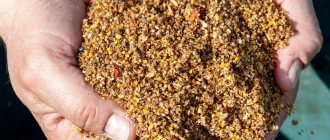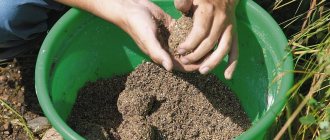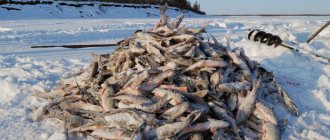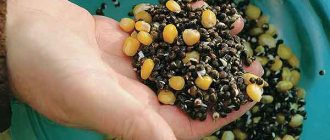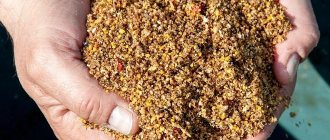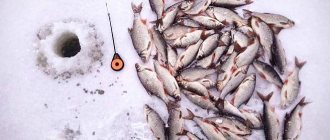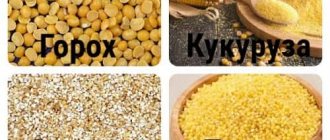What you need to know to prepare bait for your feeder with your own hands
Any feeder bait consists of a base and additives. Their ratio ranges from 80/20 to 50/50. To simply attract fish, one basic is enough. But to really interest her, to make her stand in one place waiting for another tasty morsel, you need a properly selected supplement.
as a base : dry cereal with a fine fraction (semolina, oatmeal, oatmeal), crushed baked goods or confectionery products, pureed cake, crushed peanuts, sunflower or pumpkin seeds, hemp seeds, coriander grains, milk powder, fish meal.
The task of the base is to provide the necessary consistency, crumbly or viscous, which will create a feed cloud in appropriate conditions. What exactly your bait should be depends on the characteristics of the place where you will be fishing.
- The stronger the current, the more viscous the bait should be so that it does not wash away too quickly.
- A mixture that is too loose will easily scatter when casting when it hits the water and will dissipate before it has time to sink to the bottom.
- The components of the base are interchangeable, but each of them behaves differently at different temperatures, transparency, and other characteristics of water.
In addition, the base should be dusty enough to attract the attention of fish even from afar. And then the additional ingredients come into play.
additive particles are larger in size. They are used to ensure that the fish, attracted by the base, find something to eat and linger in search of new delicacies. The additive loaded into the feeder should not scatter far, causing the fish to circle around the baited hook. At the same time, the radius should be sufficient so that even the most fastidious gourmet forgets about caution and cannot deny herself the pleasure of eating your treat.
For this, steamed bran, wheat, pearl barley, peas, corn, and various cereals are used. Of the animal components, chopped worms, bloodworms, and maggots are added to the bait.
- An important rule: the bait must contain a delicacy that is used as bait on the hook.
- To cook porridge for bait, just bring the cereal, filled with water in a ratio of 1:2, to a boil, then wrap the pan and put it in a warm place overnight. A small amount of cereal (for example, a glass) can be steamed in a thermos.
In addition, the bait for the feeder contains flavorings and natural flavor enhancers that stimulate the fish’s appetite. For this use:
- aroma oils;
- fruit syrups;
- honey;
- caramel and caramel essence;
- coffee, chocolate, cocoa;
- vanillin, cinnamon, ginger;
- other fragrant spices.
Modern industry offers an artificial substitute for each of these ingredients. However, experienced fishermen claim that fish like natural products more and bite on them more often.
How to fill a feeder feeder with bait
Filling the feeder with a mixture of base and additives or laying them in layers is not important. In each specific case, you can try both options and decide which one works better in your conditions.
Much more important is how firmly to compact the bait . The feeder should be released within 5-10 minutes to form a stable bait spot. This is what determines the desired density and viscosity of the prepared treat.
Three bait recipes for small rivers
102
We recommend viewing
The long-awaited summer, it's time for vacation! Many of us, even for a week, will go to the country or to the village, away from the bustle and noise. And, of course, we take fishing gear with us! Often recreation and fishing take place on small rivers, about which no meaningful information can be found. But there is fish there, and it’s not bad at all. Therefore, in this article we will talk about how and what to feed fish.
The peculiarity of small rivers, the width of which is no more than 50 meters, is that in summer it is difficult to meet a large school of fish in them, since all the fish are dispersed along the river. Some types of fish, such as bream, can swim in small schools of 10-50 pieces over a fairly large area in search of food. Therefore, when preparing for fishing, we must take this feature into account. The quantity, composition and consistency of bait, fishing tactics and, in general, the whole general approach to the process should be somewhat different, unlike in large rivers.
My opinion is that we prepare bait and bait to catch a certain type of fish, and this fish absolutely doesn’t care what gear we use to catch it. Therefore, I do not separate feeder baits from float baits. The feeder uses a little less bait, and my composition is the same for both types of fishing. To properly prepare bait, you need to take into account the fishing conditions and the type of fish. The main fishing rule: fish can only be caught where they are. Therefore, we choose a place for fishing not where it is convenient for us, but where the fish can stay.
Let's start with catching roach. By-catch may include chubs, silver bream, dace and other fish. In summer, roach behave differently: they can stand in the current at half-water and grab only a certain, quickly passing bait. Or it can stand under the grass or in a snag and go out only to feed it correctly. We cannot predict its behavior in advance; this must be sorted out at the reservoir.
1st fishing option.
We prepare bait for catching roach in mid-water or near the bottom.
In float fishing this is fast retrieval without holding, in feeder fishing it is fishing with a light bait, a thin hook and a long leash. The river bottom is relatively clean, the main current is 10-20 meters from the shore, or a little more. We'll catch roaches there. It is typical for small rivers that the hotter the weather, the larger the current the roach stays on - there is more oxygen there and the fish feel better.
For one portion of bait to fish for 3-4 hours, you will need:
Sensas Etang – 0.5 kg,
Sensas Gardons (roach) or Gros Gardons (large roach) – 0.5 kg,
ordinary dark heavy soil from molehills or from a darkened river bank - 3 kg.
First, mix the dry ingredients together and add water in small portions. Do not over-moisten the mixture, this is especially important! Let the bait absorb moisture for about ten minutes and mix the soil with it in the proportion: 1 part bait to 3 parts soil. This composition is optimal for Sensas baits and I have already tested it on thousands of fishing trips. That's it, the bait is ready, you can move on to fishing.
In order not to overfeed the fish, there is no need to do a large starting feeding. Remember, in the summer in a small river, when there is no migration and the fish have dispersed throughout the reservoir, there cannot be “infinite” stocks of fish. Therefore, the main task is to collect nearby fish with bait. Therefore, 3-4 small bait “tangerines” will be enough for a start. The bait balls should reach the fishing spot, but they should not lie like a stone on the bottom. To do this, we adjust the force of compression of the balls with our hands.
Slightly dry bait will quickly “break” the balls, some of it will float with the flow, but some will settle to the bottom and will gradually erode, attracting fish to this place with its aroma. It is necessary for us not to look for fish with bait, but for the fish to stand on the baited place and look for the bait itself. The more crowded we manage to collect fish, the more competition it will have, the more excitedly it will bite!
And if we overfeed her, she will quickly lose interest in the bait.
If the fish is under a carpet of grass, and we want to catch it above it, then in this case we will have to give up the land. To force the fish to rise up, and this succeeds only in half of the cases, we add about a kilogram of steamed sunflower cake to the bait. Yes, yes, the most ordinary cake. It needs to be steamed so that it “wake up” and at the same time become heavier. In this case, we moisten the bait a little more, it is the bait that will retain the fish at the fishing site and feed it in very small portions. But, if you are not used to fishing in such conditions, then there is no need to spoil your nerves. It’s better to find a place with at least 2-3 meters of clean bottom and feed there – there will be results!
2nd fishing option.
When choosing Sensas baits, those who have been working with them for many years are not guided by what fish it is intended for, but look at the size of its fraction, its color and how it behaves in mixtures with other baits. Therefore, do not be surprised by some of the things that I will now advise you. My bait recipes have been tested by dozens and hundreds of fishing trips and confirmed by excellent catches in many countries, under different fishing conditions.
Fishing with the goal of catching what lives in the river or just catching everything. To do this we take:
Sensas Attractive Bream (bream) – 0.5 kg,
Sensas Gros Gardons (large roach) – 0.5 kg,
Heavy soil, but not clay - 3 kg.
We mix dry baits and begin to moisten them, adding 50-100 grams of water and stirring until the stage when we can form a ball with one touch of the hand. Let the bait sit for about ten minutes and mix it a little more. If necessary, add water, soil, and mix everything again. That's it, the bait is ready!
It is in the highest consistent quality, as well as in the ease of preparation, that the full power of Sensas baits is revealed! It allows us to devote more time to fishing, and not to guessing whether the bait turned out or not.
3rd fishing option.
For catching bream, bream or large crucian carp in calm sections of rivers, this bait mixture recipe works great:
Sensas Carp – 0.5 kg,
Sensas Bream – 0.5 kg,
soil – 3 kg.
The result is such a nourishing and complete mixture that absolutely all the fish come to it - small things can quickly get enough, but it’s difficult to drive large fish away from this bait. For everything to work as it should, the bait must be very well moistened. This requires a little more time than moistening the mixtures described above.
But it’s worth a little more work - carp bait absorbs a lot of water, but not right away. Therefore, we moisten the bait to a consistency where we can form a ball with one click, after 10-15 minutes we moisten it again and mix. Let it sit for another 5 minutes, and only then add soil.
The soil perfectly absorbs the aromas of bait and a tasty-smelling spot is formed at the bottom, which perfectly attracts fish! She's drooling... and there's nothing to eat except our nozzle. So the fish eagerly grabs our bait. We see a bite, we hook, the rod is in an arc, the line is ringing... Great!
Interesting article to read:
- 10 tips for success on small bodies of water
- Winter fishing on small rivers
- Winter pike fishing on small rivers
Universal bait for crucian carp, bream and carp
Universal bait for crucian carp, bream and carp
In addition to its versatility, this feeder bait is also good for its low cost (due to the cheapness of the components) and speed of preparation.
The basis:
For 5 parts of flour products (crumbs, crushed cookies, crumbled gingerbread or baked goods), take 1 part:
- bran or broken rice (dry),
- sunflower cake,
- semolina,
- corn, barley or other fine grains (chaff), crushed rolled oatmeal or oatmeal.
The proportions can be slightly adjusted taking into account the fact that bread, semolina, oatmeal, chaff or corn grits, when swelling, make the bait sticky. The bran and cake create a cloudy cloud that attracts fish from all over the pond.
It’s good to mix a little dry milk, crushed roasted seeds or peanuts, crushed flax seeds, hemp or coriander into the base. You can also use some commercial bait that is suitable for the season, the body of water and the fish you want to catch.
Additive:
- to attract crucian carp and carp , barley is cooked;
- for bream , steamed peas are added to the bait base;
- all species respond well to bright yellow millet.
Hunting in Kuban
Details Category: Bait for fish
In the minds of many fishermen, preparing bait for fishing is not a difficult problem. According to their ideas, for this it is enough to combine cake, porridge (and it doesn’t matter what kind), mixed feed (or waste from
flour milling industry), anise (as a flavoring). Some may add “exotica” in the form of roadside garbage, waste products of herbivores. All this is correct and effective, but it represents the bait compositions of bygone times. They were known back in the 18th…19th centuries.
Now the selection, due to the emergence of new materials, substances, a more complete understanding of the life activity of fish behavior, has become more selective, and therefore more difficult. Much has already been written about the production of groundbait. But there is little information about the rules for its selection, including its properties. The latter is discussed later in the article.
Criteria for the attractiveness of bait
The criteria are determined by the properties of the bait, which ensure the approach of the fish to the fishing spot. The most important and important of them are taste, smell, visual appeal.
Taste and smell are based on substances that dissolve in water and act on the organs of smell and taste of fish. The difference between them is how the underwater inhabitant perceives them - through the nose or mouth. Visual attractiveness (movement, blur, color) affects the fish through its vision.
Taste and smell of bait
These criteria are created by introducing flavoring and odorous components into the composition of, for example, feeder bait. Their solubility in water depends on the density of the substance itself and the degree of its grinding. The quantity affects the concentration of particles (molecules) in the bait area and decreases from its center to the periphery. In addition, the level of concentration is not constant and decreases over time. The effect of these substances on fish is different. If there are a lot of them, an excess of smell and taste appears, which can scare away fish. Therefore, you should always try not to overdo it with the flavoring of the bait. This will allow you to immediately “interest” the fish, not scare it off, and not delay the approach until the con level drops.
Odor additives in bait
When adding additives to bait in the form of flavorings, you should use the principle “less is better than more.” This is especially true for substances with a strong odor (essences, vanillin, coriander, anise). A criterion for the sufficiency of their input can be a person’s sense of smell: the smell of substances should be barely detectable by the human nose.
Flavoring additives in bait
Bait taste is usually not that important for fishermen. This is also explained by the fact that taste buds in fish are less sensitive than smell buds. Although its effect on fish should not be completely ignored.
Visualization of bait
The visual effect of the bait affects fish at a shorter distance than its taste and smell. But the influence on the behavior of fish is more significant: when they see food descending (which does not arouse suspicion), they immediately approach it. The effect of bait is visually limited by the illumination of the water column, its turbidity, and the visual characteristics of the fish. The turbidity and color are especially attractive to timid and curious individuals: bleak, perch, and juveniles of other fish.
Large fish are always more careful and may be frightened by the unusual nature of the bait and its bright color. The latter is especially noticeable when there is little fish activity. At this time, it is better to use black and dark brown bait colors. In other cases, you can experiment with bright colors, among which the greatest attractiveness and visibility are in red, yellow, and white. The visual appearance of bait is affected not only by the color of the particles, but also by their size. A spot of them on the bottom or a cloud of turbidity will be more noticeable with smaller fractions of the substance.
Viscosity and severity of bait
These properties also affect the performance of baits. Their combinations indirectly (through visibility, taste, smell) always affect the catch.
Groundbait viscosity
This property reflects the ability of fish bait to form a lump under some compression and crumble as a result of some force (impact on the water, bottom). Extreme manifestations of viscosity: the collapse of the lump at the bottom after a while (after saturation with water) and its complete disintegration when touching the surface of the water. Viscous bait is used when it is necessary to deliver it to the bottom (they catch bottom fish), for casting over long distances using a slingshot or hand. Loose - fishing in the thickness or near the surface of the water, near the shore.
Lure weight
This property of the bait determines the speed at which it will sink to the bottom. The light one does it more slowly, and its use is effective in calm water. Heavy - fast, and lies compactly on the bottom longer. It is used when fishing for bottom fish in the current. The viscosity and severity of bait, without changing the quality of the composition, can be changed in two ways. The first is based on different wetting: less water when preparing bait
– it is more crumbly, lighter; Fine
– more viscous, heavier; more - crumbly, heavier.
When designing bait, take into account: - when used in water, crumbly bait is separated: small particles behave as light, large particles act as heavy; — small particles always make a lump more sticky.
Choosing the optimal bait
specific conditions are difficult. It is even more difficult to assess the optimality of its composition. This can be done objectively only by comparing the results of the catches of two fishermen sitting next to each other using different baits. Moreover, several mandatory conditions must be met:
— fishing is carried out in calm water;
- an equal amount of bait is used;
— feeding is carried out at the same rhythm;
— the same methods of delivering bait are used when feeding.
But even when conducting experiments with the conditions described above, the results may differ among fishermen. It should be taken into account that more optimal bait can “promote”, for example, a smaller catch, but the presence of larger fish in it. Or allows you to catch a specific type of fish.
Combination of bait properties and fishing conditions
In practice, there are four such combinations:
- depth + flow = severity + viscosity;
— shallow water + current = heaviness + looseness;
- depth + standing water = lightness + viscosity;
- shallow water + standing water = lightness + looseness.
It is precisely these combinations that allow bait to exhibit its best properties: to act actively, to collect fish in the area where the gear is located. There are, of course, exceptions. For example, you are fishing at depth in still water. And the upper layers are full of small fish that ruin your life. Here it is better to use heavy bait. In any case, “successful” complementary food should fall apart precisely in those layers of water in which fishing is carried out.
Groundbait components
Substances added to bait are divided into 2 large groups:
- activators that can attract fish by movement in the water column, color, taste, smell;
- base (otherwise “ballast”)
– substances that are less attractive, but preserve bait and ensure its effectiveness.
The latter allow you to change the properties of the bait for different fishing conditions and situations. Read more about some of them below.
Bran, ground seed husk
This “ballast” is the most crumbly and lightest known. It has low calorie content, fish will never get enough of it. A large amount of it in bait makes it less attractive.
Clay
Fishing baits with such “ballast” are used when they require viscosity and heaviness. Clay made from small grains is better than dusty clay. The latter makes the mixture very viscous.
Sand, gravel
This “ballast” makes the bait crumbly and heavy.
Flour, egg powder, milk powder
“Ballast” of these substances helps make the bait viscous, noticeable to the fish visually and by smell. In a light, water-soaked mixture, substances increase the amount of turbidity created by the bait.
Breadcrumbs
This “ballast” is one of the most effective; almost every universal bait contains it. Finely ground, it helps the bait become viscous and heavy. Its good taste allows it to be used as a “diluting” component. The lack of odor of breadcrumbs is compensated by aromatics.
Crackers can be white, black, differ in smell and taste. This is taken into account when preparing bait. From the described components, a “ballast mixture” is selected for almost any fishing conditions. Of course, you can add other substances to them, but in practice, 2…3 of those described are quite enough. Just don’t give preference to components with diametrically opposite properties in one recipe. Especially in large quantities.
Components that give bait smell and taste
Cake
This name refers to the mass obtained as a result of fine grinding of grains and seeds of oil-containing plants. And made from fresh materials. These are the components that can give bait a good, real taste and smell. To strengthen the latter, the seeds must be roasted before grinding. A large amount of cake in bait is used when catching large fish. Especially in bait for bream and white bream. For small fish, it is better to abandon it and add other flavoring additives.
Sunflower cake
Its color depends on the degree of roasting of the seeds and can be gray, gray-brown, or brown. They have a lot of husks, and they are very thick. It slowly gets wet in the water and greatly loosens the dense clumps of bait when it surfaces. Cake is the cheapest of its analogues, therefore it is often used by fishermen. A small amount in the composition attracts different fish, a large amount - more often than bream.
Hemp cake
The material is dark, usually grayish in color. The shells are semicircular and difficult to crush, so the lumps in the bait are well loosened. The smell of hemp is pungent, so the cake is added to the bait in small quantities. The component is added mainly when preparing bait for roach.
Flaxseed cake
This component is brownish, red or yellowish in color, with a mild, slightly herbaceous odor. The grind is always fine, but coarse. Helps loosen groundbait. Works well on white bream.
Rapeseed cake
This is the most “inconvenient” component for preparing cake bait. Its small, spherical seeds are very difficult to grind. The color of the component is almost black, brown-black or brown. Its smell is not strong, reminiscent of that of heavily fried rye crackers. It is more often used as a “roach” component.
Pumpkin cake
The color of this cake can be white, yellow or an intermediate color and depends on how much the seeds were roasted. It contains a lot of husks that are difficult to grind. Ideally, the component should be sifted before use. The peel does not get wet well and quickly “falls apart” lumps of bait. The cake has a strong smell. It is used in bait for white fish, when fishing in calm water and shallow depths.
Aromatic components
These additives can replace cakes in terms of aromatics. What is important when grinding the latter is difficult.
Nuts
In terms of properties, this component (hazelnuts, peanuts, hazelnuts) is close to “classic” cakes. The difference is the absence of husk, which affects their performance characteristics. Ground nuts have a “bright” smell and aromatic effect. In groundbait, its viscosity and heaviness are increased.
Exotic plant seeds
Unlike cakes, such components have a rich odor. They are added to bait in small quantities: 5...50 g per 5 kg of mixture. Seeds from umbrella plants (fennel, cumin, star anise, coriander, anise, dill) should first be ground. The use of some of them often leads to a drop in biting activity.
The appeal of flavors
In decreasing order, the effectiveness of using aromatic substances in bait for different types of fish is as follows:
— bream: coriander (4); sunflower, flax, banana (3); cinnamon, pineapple (2); peanuts, dill, apricot, milk, strawberries (1);
- roach: hemp, anise (4); fennel, barberry (3); apple (2); rapeseed, dill, pear, vanillin, peach, strawberry (1);
— universal: peanuts, pear, vanillin, strawberry (3); cinnamon, apple, pineapple, apricot, peach, strawberry (2); flax, rapeseed, sunflower, dill, barberry, banana (1).
The numbers indicate the vote for the flavor by 4 experts.
Food aromatic essences
These are esters that resemble the smell of certain fruits, flowers, and fruits. Previously produced as an alcohol or oil solution of varying concentrations. Use 0.5...1 ml (5...10 drops) per 1 kg of mixture. The most common “smells” of essences that are effective in bait: raspberry, milk, barberry, apricot, peach, vanilla, banana, strawberry, strawberry, pear, apple, pineapple. Essences are almost difficult to find in retail today.
Recommendations for the use of aromatic additives
Such recommendations are part of the experience of many anglers. They are as follows: - the total proportion of several flavors should not be greater than that which was used when using one of them; - be careful when using new, untested spices; — large fish prefer higher quality components;
Flavoring components
Cookie
A characteristic feature of all types of this additive is high viscosity, caused by the possible fineness of grinding. After grinding, especially with an electric mill, sieving is required to remove large pieces.
Gingerbread without filling
Due to high humidity, this product is difficult to grind without drying. Gingerbread gives the bait a decent heaviness and significant viscosity. When preparing bait with your own hands, you need to remember that the use of gingerbread often eliminates the need to introduce additional flavorings.
Waffles without filling
The waffles don't have a distinct flavor, but using them greatly improves the mixture. Specific properties: lightness, friability. Due to their light color, they are good as bait for shallow water, fishing near the surface of the water, and for feeding with a “column” of turbidity. Wafers make it easy to change the properties of baits.
Powdered milk
This component is used to give the bait flavor and viscosity. In the first case, it requires a little dry milk, in the second - a lot. In addition, this additive is used when it is necessary to create a “column” of turbidity in water.
Sugar
The component is introduced to add sweetness to the bait. In large quantities, it can increase the stickiness of the mixture. Its presence in bait, according to many anglers, attracts more small fish.
Salt
This component should be used with caution. In most cases, it reduces biting activity.
Cereals
Most grains are added to groundbait as ballast or simply for quantity. Although they also affect the taste characteristics of the bait. The best cereal for mixtures is millet (otherwise known as millet). Next comes wheat and cracked corn. For large fish, boiled rice is used. You can also add semolina, but you need to take into account its strong swelling when wet. Ready-made porridges must be cooked. Be friable and mix well with other bait components.
Author: V.A.N.
- Fishing
- Lure
- Back
- Forward
Bait for bream
Using the same components as indicated above, we adjust the composition to the preferences of the bream:
- slightly reduce the dusty components - they attract small fish, the bream will swim past the swirling school;
- thoroughly mix the bait until smooth - the lumps will quickly saturate the fish and make them leave;
- Natural flavors are preferable - vegetable oils, spicy seeds, extracts, mashed fruits and berries.
In winter, it is better to completely abandon bright odors, adding protein elements instead - bloodworms, worms, maggots, burdock. A suitable attractant during this period would be dry blood (at the rate of 1 tbsp per 1 kg of prepared bait).
Depending on the color of the bottom, the shade of the bait is adjusted:
- for areas with a dark muddy bottom, bait made from rye crackers is better;
- For a light sandy, dense clay bottom, wheat bread, muffins, and light cookies are more effective.
Store-bought mixtures or homemade baits
Store-bought mixtures are quite effective, but they are usually expensive. Budget compositions usually do not suit anglers. Therefore, the best option is to make baits at home on your own. Such baits will be no less effective than store-bought ones if you use the right components and in a certain quantity. It is definitely impossible to choose the ideal bait for bream. A mixture that works flawlessly in a pond may fail when fishing on a river. In one place, give the fish a sweet mass, and in another place it is attracted by strong aromas. Fish behavior is often influenced by:
- weather;
- lack or excess of food in the reservoir;
- season.
It is also difficult to give preference to bait from a store or a composition made by yourself. We can only determine the most important criteria for the working mixture.
- The bait for bream should be aromatic. Bream responds well to an appetizing smell, but too high a concentration of flavoring can scare away the fish. Bream is a fairly large fish that loves bait with large particles. But it is important to observe moderation. Too large particles of bait will quickly saturate the fish and it will leave the feeding area. Basic components of bait prepared at home:
- millet, pearl barley;
- cake;
- bran;
- breadcrumbs;
- Hercules;
- peas;
- corn.
- The composition should contain those products that fish love.
- All components of the bait must be crushed and mixed thoroughly. A large number of large fractions can quickly saturate the fish.
- The presence of a large number of too small (dusty) components (cocoa, milk powder) will attract small fish , which will interfere with the fishing of bream and bream.
Feeder bait for crucian carp
- 1 cup oatmeal;
- 1 cup breadcrumbs;
- 350 gr. crushed cake (seed cake is also suitable);
- 100 gr. crushed roasted peanuts;
- 150 gr. live food that will serve as bait.
It is good to flavor crucian carp bait for the feeder with vanilla or anise.
An excellent result is also obtained if, before casting, you add effervescent vitamins to the feeder with bait. This technique arouses interest even among well-fed and sleepy fish.
Autumn bait for catching bream on a feeder
Bait for bream
- 1.5 kg breadcrumbs;
- 1 kg of ground cookies;
- 1 kg oat flour;
- 1 kg of corn grits;
- 0.5 kg of rolled oats;
- 0.3 kg of roasted seeds;
- 60 gr. ground cinnamon;
- 0.25 gr. cocoa powder
The consistency of the finished bait can be adjusted on site by mixing coastal soil for viscosity.
Flavorings for bait
To give bream bait an irresistible smell, various flavoring agents are used.
- Coriander has a sharp but pleasant smell. You need to grind it immediately before fishing to preserve the aroma.
- Cumin seeds , ground in a hand mill, are in demand among the bream.
- Dill seeds are added in a crushed state (powder) up to 2-3 teaspoons per 1 kg of bait.
- Liquid flavors are widely sold with the smell of banana, apricot, vanilla, strawberry, etc. They are used in those reservoirs that are widely visited by fishermen. Not recommended for use in wild lakes. The flavorings must first be diluted in the water that will be added to the bait.
Experience and a creative approach to selecting the composition will help the fisherman create an effective bait for bream. You need to boldly experiment with the addition of different coastal plants that can stimulate the appetite of bream. But this must be done intelligently and carefully. It is better to start adding odorous ingredients with a low concentration, and then gradually increase the dosage. This is how working baits are created, which become the basis for successful fishing.
Summer bait for feeder fishing on the river
- 400 gr. sunflower cake;
- 200 gr. breadcrumbs or bread crumbs;
- 400 gr. ground peas;
- 400 gr. boiled rolled oats porridge;
- 6 teaspoons ground coriander.
The pulp plays the main role in this recipe. It can be from sunflower seeds, pumpkin, hemp, rapeseed, flax. The taste preferences of fish in each body of water vary depending on the season, weather, and time of day.
Clay becomes the binding component. By mixing it, you regulate the viscosity of the bait and the speed at which it is washed out of the feeder.
Composition of bait
Now some simple tips about the composition of bait. What are the rules regarding this? Perhaps the very first rule is the consistency of the composition of groundbait and bait. Everything is simple here - for successful fishing, elements of bait are added to the bait, but, let's say, of lower quality. For example, if you decide to use Hercules oatmeal as bait, then you must add crushed oatmeal or screening out the same flakes to the bait. If the basis of your bait is breadcrumbs, then balls of dense dough mixed with the same breadcrumbs are better suited for bait. If, for example, you are planning to fish with maggots, then please add small maggots or their pupae to the bait. If the bait is a worm, then the bait should also contain small or chopped worms. This is a simple principle.
The simplest and probably the most common bait composition is a mixture of breadcrumbs, oatmeal and wheat bran. The composition, although simple, is not inferior in effect to many branded mixtures. This composition can safely be called universal. It’s just that for different fishing conditions you need to use different proportions of the components. I will explain the meaning of what was said. Let's say you are going fishing in a pond with standing water. To be successful, you need looser groundbait. This means that you need to add more wheat bran to the bait; it is they that will make your bait not so viscous. Balls of such bait easily disintegrate in standing water.
For fishing on a river where there is a current, bait is needed that is denser and more viscous. For this purpose, more oatmeal is added to the bait. If the current is strong, then even stone chips are added to the bait. The balls of such bait become heavier and sink to the bottom faster, without deviating from the given bait location under the influence of the current.
By the way, the composition of such a universal bait goes well with various flavors - it’s up to your taste. Probably every self-respecting fisherman has his own “secret” smells of branded or natural attractants. Feel free to experiment in this matter.
Source: What and how to feed fish
“Fried” bait for white fish
This mixture is perfect not only for the feeder, but also for sculpting bait balls when fishing with a float rod.
- 400 gr. wheat;
- 200 gr. Hercules;
- 100 gr. sunflower seeds;
- 400 gr. breadcrumbs;
- 100 gr. powdered milk or rice flour (you can use powdered infant formula);
- 400 gr. corn grits;
- 50 gr. flax or hemp seeds;
- 50 gr. vanilla sugar;
- Red food coloring or finely grated beets.
Alternately fry wheat, rolled oats, sunflower seeds, flax/hemp seeds in vegetable oil until golden brown. Grind them in a coffee grinder. There is no need to wash it into dust; let the bait contain elements of a large fraction - this is more likely to attract large fish.
Flax or hemp seeds must be present in the composition. It has long been proven that they have a laxative effect on fish. Thanks to this, she cannot get enough, continuing to spin around in the place you fed.
Mix the roasted grains and seeds with the remaining ingredients.
We paint with beets directly on the spot, before filling the feeder and casting. It is the red color that perfectly attracts white fish even in muddy water.
Additives to bait
Let's try to summarize in one article all the most interesting bait additives for fish and available to fishermen.
1. Spices
The classic powdered bait additive is spices. With their help, you can mix fragrant varieties of bait yourself, or you can add additional attractiveness to ready-made bait from a bag. It is good to mix spices into dry bait and thus distribute their smell evenly.
But moistened bait can also be changed with the help of spices. Often it is enough to simply sprinkle a little odorous substance onto the ball of bait. This way, not all the bait is flavored at once, but different spices are tested on individual balls. Classic ones for floaters are anise, coriander, fennel, vanilla cookies, gingerbread and cinnamon.
2. Flavors
Flavorings play the same role as spices. Some spice mixtures can be purchased and used as flavorings. But the aromatic substances in jars have a much higher concentration than spice mixtures. When added to groundbait, careful dosage is necessary. An overdose of bait mixtures has a rather repulsive effect on fish instead of an attractive one. Known flavors include garlic, vanilla, caramel, anise and nut. Both with the help of flavorings and with the help of spices you can change the smell of the nozzle. Add a minimal amount of them, for example, to maggots or treat wet sweet corn with them.
3. Food colors
Often the color of the bait plays a special role. To give it a certain color tone, food coloring is used. It would be more correct to say that they are added to bait. The dye can be mixed into dry bait, but you can also recolor already moistened bait. There is a wide palette of dyes on sale from white, yellow, brown, red to black. How intensely to color the bait is a matter of taste for the fisherman. The intensity is varied by the amount of dye that is mixed into the bait. When purchasing, pay attention to the fact that these are food-grade and not artificial chemical dyes. The dye must dissolve in water. In spring, red bait often attracts fish to the fishing spot, especially in muddy water. Respectable fish in summer respond better to yellow coloration. Brown coloring is good for late summer and autumn, black coloring is good for clear cold water in winter, and white coloring makes small fish rise to the surface in summer, as well as schools of larger bleak.
Read: Summer bait for crucian carp
4. Sweet substances
At high temperatures, non-predatory fish, especially carp and large bream, love sweet bait. You can add sugar to it. But there are also powdered concentrates, often marketed as sweeteners or boosters. Sweeteners should be added carefully, as they are usually very sweet. One teaspoon per 2 kg of bait is enough. Of the boosters in the summer, the laclo mixture is especially highly valued, which has become a legend for many floaters. But special boosters for walking also attract these bottom-dwelling fish to the feeding area.
5. Binders for bait
If the bait needs to have a higher viscosity, for example because the strength of the current has changed, binders should be added to it. They make the bait more viscous; it does not disintegrate immediately, but remains at the fishing site. Binders can be added to both dry and already moistened bait.
6. Create a cloud
When fishing in mid-water, on the surface and in shallow waters, the cloud that attracts fish often has a decisive effect. True, it can be created using food coloring, but it is better to use a special cloud shaper. They sprinkle the bait or add it using a Pole Cup. Cloud formers come in a variety of colors. Light colors such as yellow are good for catching bleak. This coloring also attracts large bream in summer. Red color excites minnows, ruffes, ides and roaches. Black color is suitable for fishing in clear water and in winter for catching roach.
Read: How to feed carp
7. Maggot cleaners
Maggots often have an unpleasant ammonia smell, which is not only unpleasant for us, but also fish do not like it. Therefore, maggots must be cleaned before fishing. After being freed from sawdust, the larvae are sprinkled with maggot cleaner. It binds odor, degreases and dries maggots. And to prevent the larvae from becoming moist again, a small amount of corn flour should be added to them. Cleaners come not only neutral, but also with different tastes, for example, fruity-sweet or spicy-fishy.
8. Glue for maggots
Pure maggots, used as bait, act like a magnet on fish on some days. In order to bring them to the baited area without scattering them too much, and also to prevent the current from carrying them away from the fishing site, maggots should be glued into a ball, which can be additionally weighted with gravel. To glue the peeled maggots, place them in a bucket, or better yet, in a flat tray. Lightly moisten them with water from a spray bottle and then sprinkle with maggot glue. It’s worth waiting a few minutes until you can form a ball of glued maggots. If this does not happen, you need to add a little more glue. The balls are thrown by hand or using a slingshot. If you need to treat gravel with glue, add it to the maggots after moistening.
Read: Fishing with a float. Feeding rudd
9. Bloodworm separators
In addition to maggot and glue cleaners, there are other powders that are designed for treating live bait or live bait. When fed with bloodworms, these red larvae require special preparation. Before adding to the soil or bait, they should be separated. To do this, add an appropriate separator to the larvae laid out on a damp newspaper sheet. The larvae and separator are then mixed. Then, pressing lightly, make rotational movements with the palm of your hand and separate them from each other. The result will be a first-class bloodworm for feeding. Bream and carp are especially fond of these little red worms.
Catchy bream bait
Catchy bait
- 1 cup pearl barley;
- 1 glass of millet;
- 2 cups corn or barley grits;
- 1 cup peas;
- 2-3 teaspoons of hemp seed;
- a few grains of cloves;
- a pinch of dry thyme (thyme);
- 1 cup pistachios or peanuts;
- breadcrumbs.
A glass of pearl barley is poured with 2 glasses of water and cooked for about 20 minutes over low heat. Then millet is poured into the same container and another 1 glass of water is added. After 5-10 minutes, thyme and cloves are added.
When there is very little water left, chaff and hemp seeds are added. Everything gets mixed up. The closed pan is wrapped in a blanket and left until the morning.
Peas are pre-soaked for 10-12 hours. Then it is cooked until soft and twisted in a meat grinder.
The nuts are roasted (in the microwave) and crushed.
Before going fishing, all components (porridge, peas, nuts) are combined. The bait is brought to the desired consistency with breadcrumbs so that it stays in the feeder for about 10 minutes. It is best to do this on the spot, having decided on the speed of the current.
Making your own bait
The composition of the bait depends on the place of fishing and the time of year. Therefore, you need to know a few basic recipes.
Recipe No. 1 (summer on standing water)
To prepare the working mixture you will need:
- breadcrumbs - 0.3 kg;
- ground roasted sunflower seeds - 0.2 kg;
- bran - 0.3 kg;
- boiled millet - 0.3 kg;
- ground coriander - 2/3 teaspoon;
- Clay is added until the ball reaches the desired consistency.
Recipe No. 2 (summer version for the river)
This bait option is designed for feeding fish in the river in summer.
- sunflower cake - 0.2 kg;
- breadcrumbs - 0.1 kg;
- boiled oat flakes - 0.2 kg;
- sprouted peas - 0.2 kg;
- ground coriander - 3 teaspoons;
- clay.
Recipe No. 3 (spring bait)
Spring bait for a pond includes the following ingredients:
- sunflower cake - 0.1 kg;
- boiled millet - 0.1 kg;
- rye bran - 0.1 kg;
- feed bloodworm - 3 matchboxes;
- ground coriander - 2 teaspoons;
- clay and sand.
Recipe No. 4 (autumn bait for currents)
The autumn mix for fishing on the current looks like this:
- wheat breadcrumbs - 0.1 kg;
- sunflower cake - 0.1 kg;
- unsalted lard (pieces 5x5 mm) - 50 g;
- rye bran - 0.1 kg;
- boiled rice - 0.1 kg;
- maggot or bloodworm - 2 matchboxes;
- ground coriander - 1 teaspoon;
- clay.
Groundbait for feeder with corn
- 200 gr. barley;
- 200 gr. millet;
- 400 gr. Hercules;
- 200 gr. breadcrumbs;
- 200 gr. canned corn;
- 150 gr. corn grits;
- 50 gr. oatmeal or oatmeal;
- 100 ml molasses;
- 10 gr. vanillin;
- 30 gr. ground cinnamon.
This bait is similar to corn when catching carp, bream, carp, roach, and crucian carp.
Cook the pearl barley until half cooked. Add millet to it and cook together.
We constantly monitor the water level: it should not be completely absorbed immediately; in the remaining 100-150 ml of liquid, the cereal will swell as it cools.
Add cinnamon and vanillin to the still warm porridge and stir thoroughly.
Just before fishing, combine the porridge and corn kernels. To bring the bait to the desired consistency, add brine from a can of corn into it.
How much bait do you need to prepare for the feeder?
With your own hands you will prepare exactly the amount of bait you need for your planned fishing trip.
We calculate the quantity using the formula:
V = (3.14 * 2D * H) / 4
V – total volume, in cubic cm;
D – diameter of the feeder used, cm;
H – height of the feeder, in cm.
Next, we determine how long the fishing is planned and how often we plan to cast. Based on this, we determine the number of casts (X).
We multiply V and X and get the required volume of bait. To determine the amount in liters, divide the resulting cm3 by 1000.
It is worth adding 10-15% to the resulting volume, and taking dry ingredients with you so that you will definitely have enough, even if the fishing lasts longer than expected.
How to store prepared bait
You can prepare dry bait for the feeder with your own hands in advance, in large quantities, and store it until the happy moment of fishing.
To do this, mix all the bulk ingredients in a large container, and then scatter them into thick plastic bags or plastic containers with an airtight lid.
When going fishing, it will be enough to combine this mixture with steamed cereals, porridge or live food to get ready-made feeder bait. This will help significantly save time, which is especially important for sudden gatherings.
If the mixture turns out to be too thick, it can be easily diluted by adding water from a reservoir. If you overdid it with the liquid, add a little dry bait from the supply you took with you.
Any flavors are added directly on site, before filling the feeder.
Inert (well-moistened) bait
Excellent for catching cautious large fish in still waters and in the current. In contrast to the methods of mixing mixtures discussed above, in which the bait quickly releases feed particles, attracting a lot of small things and soon no longer being of interest to large fish, the method of producing inert bait involves holding the nutritious feed components at the bottom for as long as possible - until The big one won't do. So this is exclusively bottom bait.
The moistening technique is well known to those who make bait at home, before fishing - after all, it takes a long time to get bait, all the particles of which are maximally saturated with water. As a rule - several hours. Exactly how much depends on the composition of the bait, the temperature of the water that we will use for mixing, as well as the air temperature (in summer, the bait mixture should be left in a cool place so that it does not ferment).
The dry ingredients are mixed by adding water in larger quantities than in previous methods - even with slight waterlogging. However, you cannot over-wet the bait, bringing it to a slurry state. Otherwise, it will become unsuitable for feeder fishing. We should have a normal, well-moistened mixture, to which we added a little more water than usual. After soaking, I, like many other anglers I know, transfer the finished mixture into an airtight container (a clean, thick plastic bag, from which the air should be released before tying, is quite suitable) and leave it for 5 - 6 hours in a dark, cool place (but not in refrigerator).
True, before using it for fishing, it may be necessary to moisten it a little more (depending on the composition and size of the fractions of the bait mixture, the amount of water “drunk” by the bait may be different), then we will use a delicate spray bottle so as not to over-moisten the mixture. As a result, we will get a fairly viscous and heavy bait that does not leave food particles when falling to the bottom, and ultimately does not attract small fish.
The work of this mixture will only appear at the bottom, where it will gradually and slowly begin to disintegrate. For example, by throwing a ball made from inert bait into a transparent container of water, we will see that for about 15 minutes it remains at the bottom almost intact. Only then, gradually crumbling, it begins to slowly lose its particles (photo 5) . And even after half an hour the ball still retains its shape.
I already mentioned above that it is better to add water to the bait from the same reservoir where the fishing takes place. But in this case we cannot do this. Therefore, we either take water from the home tap (if it is not highly chlorinated), or dilute the mixture with any drinking water available to us. This can be spring water or from a well, as well as store-bought bottled still water without any additives.
The temperature of the water with which we soak the bait also affects the quality of the latter. Firstly, hot water soaks the mixture faster, but the time it works at the bottom will be reduced - it will quickly lose its nutritional and aromatic qualities. And, secondly, hot water will give the bait more viscosity.
Inert bait is used in classic feeder feeders in medium-deep and deep standing reservoirs due to the fact that it will remain in them for quite a long time and will not be washed out when immersed. In addition, it is suitable for use in bodies of water with a current, where it will gradually erode, leaving a trail of food particles at the bottom. And, of course, a mixture of this consistency will be perfectly retained in Method type feeders (photo 6) .
Where to buy bait products
If you purchase bait products in regular stores, the cost of the finished mixture will be no less than that purchased. But there are some secrets that will help you save a lot.
- Bran, wheat, millet, corn, buckwheat (green) should be bought in stores that sell feed for poultry.
- In retail outlets selling confectionery products, you can buy scrap cookies at a reduced price. Sometimes manufacturers sell substandard products - it’s even cheaper.
- In specialized stores and confectionery departments where ingredients for cakes are purchased, you can purchase vanillin, cinnamon, cocoa, fruit syrups and essences by weight. It's much cheaper than packaged spices. For example, 1 gr. A bag of vanillin costs 5 rubles. By weight, the cost of 1 kg of vanillin is 400 rubles; It is not necessary to take a kilogram at once, they will weigh less.
- Breadcrumbs can be replaced with stale bread, minced in a meat grinder or food processor. In a bakery store, as a rule, substandard bread and bread that was not sold on time are sold at a reduced price. The fish will not guess about this - you can safely use it.
Preparing bait for a feeder with your own hands is a creative and exciting process. By trying different recipes and making your own adjustments to them, you can experimentally select those combinations that not a single fish in the place you feed can resist.
